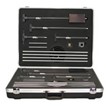Biconical Antenna Selection

For many years most regulatory standards called for the use of a half-wave dipole antenna set for frequencies above 20 MHz. However, to reduce test time, broadband antennas such as the biconical antennas began to be accepted. Broadband antennas, compared to half wave dipoles, reduce test time because the technician does not have to stop the test to adjust the dipole element length for each frequency of interest.
The biconical antenna is considered a standard workhorse for every compliance test lab. Used in a variety of applications such as radiated emissions, immunity and shielding effectiveness testing; this antenna has proven to be a valuable asset. Biconical antennas are also used for Normalized Site Attenuation (NSA) measurements, site evaluation (CISPR 16-1-4 SVSWR procedure) and spectrum monitoring applications.
In recent years the development of higher frequency biconical antennas have expanded their capabilities and usefulness. This application guide will explain the typical antenna properties, specifications and applications of biconical antennas.
Get unlimited access to:
Enter your credentials below to log in. Not yet a member of RF Globalnet? Subscribe today.
